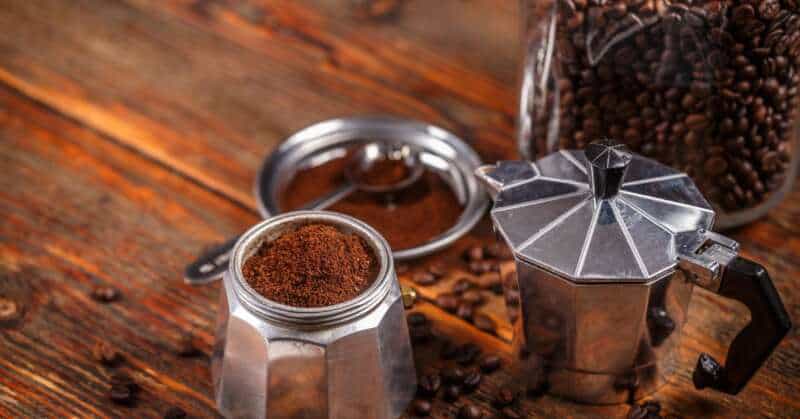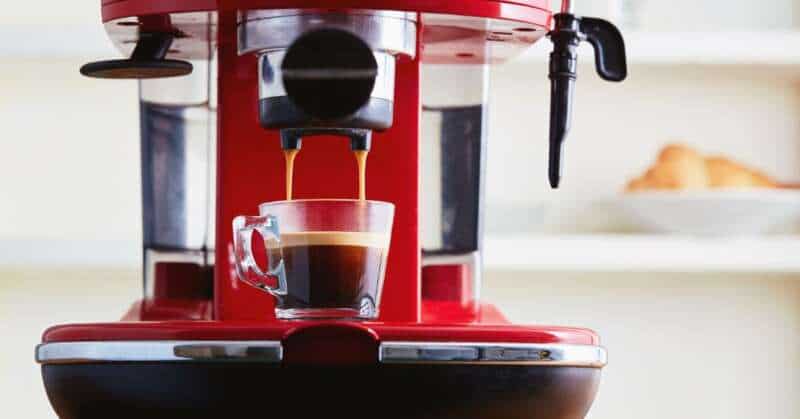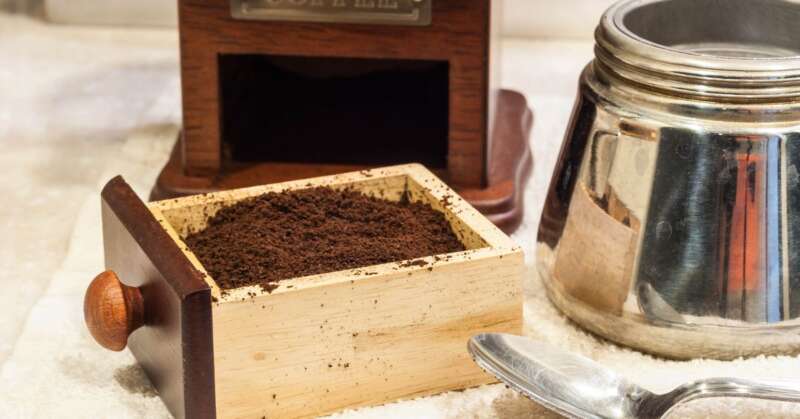Suppose you were in an Italian home and speaking to someone of an older generation.
In that case, you’d be told that the best coffee maker around is a Moka pot. Next, go to an Italian coffee shop and talk to a barista.
Again, you’ll be told a high-end espresso machine is the way to get the best coffee.
But which one is correct?
Related: So what if you’re at home and you need an espresso? Check out our handy guide on how to make espresso without a machine for some tips.
In this article, we will look at Moka pot vs espresso machine coffee to see which one you should choose.
Different Ways to Make Coffee
There are so many ways to make coffee that it can be challenging to know where to begin. Whether your go-to is a Moka pot, an espresso machine, a bean-to-cup machine, a percolator, a dripper, or a french press, no one will agree on the best.
As we can’t focus on every type at once, today we’re looking at Moka pot vs espresso machine coffee.
Since capsule machines and home espresso machines have arrived on the scene, the good old-fashioned Moka pot has fallen out of favor.
However, many people are seeing a resurgence of the trusty Moka pot after trying other methods and preferring the strength and flavor of this traditional coffee-making device.
Which is best, the Moka pot or the espresso machine? Let’s look at what each one offers in turn.

What Is a Moka Pot?
A Moka pot is a stovetop coffee maker that uses steam pressure to brew coffee. These are handy machines that are simple to set up and use. Depending on the size of the Moka pot, you can have coffee in as little as 4 minutes.
Related: Check out our post on how to use a moka pot on an induction stove.
A Moka pot has three main components – a lower chamber where you place cold water, a middle section with a funnel and a basket to place coffee grounds, and an upper chamber where the brewed coffee is collected.
The coffee produced has a deep and rich flavor that pairs well will milk.
What Is an Espresso Machine?
An espresso machine makes espresso coffee. This type of coffee is a short, strong cup of coffee with a concentrated flavor and high in coffee oils. The machine is sophisticated and forces hot water through coffee grounds to produce a rich flavor.
Espressos are excellent on their own but are also the base of other coffee drinks like cappuccinos and lattes.
There are different types of espresso machines available, and you can pay under $100 or over $10,000 for one. You can find ones that take pods or capsules as well as ones that take ground coffee.
A bean-to-cup espresso machine will grind the beans and make coffee for you.
Is a Moka Pot Coffee the Same as An Espresso Machine Coffee?
Firstly, the coffee you get out of a Moka pot isn’t espresso, so we can’t talk about like-for-like when we’re debating Moka pot vs espresso machine coffee.
Moka pots brew coffee similar in quantity to a French press or regular drip coffee maker but dark and intense like an espresso. You don’t get crema with a Moka pot, so it does need milk. That said, its flavor is complex and earthy, just like espresso.

Can You Class Moka Pot as Espresso?
No, the coffee from a stovetop espresso maker isn’t authentic espresso. This is because the Moka pot brews coffee differently. It’s still a great coffee with a rich, deep flavor, but it isn’t espresso.
An authentic espresso is made with finely ground coffee and between 8 to 10 bars of pressure. The extraction takes around 25 seconds. Moka pots brew in an entirely different way, so their end result isn’t espresso.
Instead of the quick, high-pressure brewed coffee, you’ve got around 1.5 bars of pressure and a longer extraction time. This means fewer oils are pulled out, but it does mean the coffee grounds are infused for longer, which extracts a deeper flavor.
Is Coffee Made From A Moka Pot Good?
When made correctly, Moka pot coffee is delicious coffee. Even though it’s not an espresso, it’s excellent in its own right.
One of the most important things to consider is your ingredients. For example, your brew won’t taste as good if you source cheap coffee beans. However, brewing coffee this way is better if you don’t have high-quality coffee beans.
This is because the brew relies less on the oils in the beans, unlike espresso machines.
Moka pot coffee is excellent with milk and has a rich roast flavor. It works best as a cup rather than a shot.
Compared to other coffee types, the Moka pot brews the most similar coffee to espresso. With a coarser grind size and a dark roast, you’ll get a similar taste to espresso, but it won’t be as sweet.
Caffeine Content Espresso Machine vs Moka Pot
Both Moka pot coffee and espresso machine coffee have similar caffeine content. Per weight, though, an espresso will be a more intense brew.
However, because you drink it as a short, one espresso will provide less caffeine than a cup of coffee from a Moka pot.
Your morning espresso contains around 120 mg of caffeine. It’s a great pick-me-up that gets straight to work. A Moka pot brewed coffee is great for those who prefer a longer drink and extra caffeine.
A standard cup of coffee from a Moka pot will give you around 240 mg of caffeine, around double that of a single espresso.
Moka and Espresso Coffee Brewing Methods: Grind Size and Beans Comparison
Suppose you’re using a Moka pot regularly. In that case, you may notice that you can’t find pre-ground coffee designed solely for this use. Again, this differs from espresso machines as you can find the proper pre-ground coffee readily and easily.
Because extracting the coffee with a Moka pot can’t be controlled, you have to ensure you get the proper coffee grounds so that your end result isn’t bitter.
If you choose the wrong type of beans or they’re too coarse, you can over-extract the Moka coffee. Unfortunately, this can also cause too much pressure to build up, resulting in sputtering.

For the Moka pot coffee brewing method, you should always use a medium to dark roast with a lot of body. Also, it would be best if you avoided something too shiny as it will have too much oil.
A light roast won’t give you the flavor you seek, and it might taste sour and over-extracted.
Also, beans designed for espresso machines will be too oily and dark for Moka coffee, and you’re likely to have a flat, sour result.
Essentially, Moka pots brew coffee somewhere in the middle. Their pucks are large and don’t need tamping.
However, the grind size creates pressure when it expands in the filter funnel to produce the flavor.
So you’ll need to ensure a grind size that’s on the way to being the size for a drip coffee maker but not quite there.
Related: For the best Moka coffee, it’s also really important to get the ratio right. Check out our handy guide on Moka Pot Coffee Ratio.
Pros and Cons of Each Brew Method
Like all coffee brewing methods, each type has advantages and disadvantages. Let’s look at both.
Advantages of Moka Pot Coffee
- Moka pots are easy to clean and are one of the best coffee extraction methods. If you have an aluminum machine instead of a stainless steel one, you’ll need to take more care. Otherwise, it’s as simple as tapping out the coffee grounds after use, rinsing, and wiping down. You’ll need to check the seal every now and then, but that’s it.
- Moka coffee can be made wherever you can access a stove or open fire. This makes them ideal for taking away with you when traveling – and even when camping! They’re rugged and robust, so you don’t need to worry about them breaking on the move like a French press might.
- Once you’ve mastered using a Moka pot, you’ll never forget and won’t have to think too much about how to make Moka coffee.
- You likely won’t pay as much. You can buy an expensive one, but a less expensive Moka pot works the same way.
Disadvantages of Moka Pot Coffee
- Moka pot coffee does take longer to make than an espresso machine. It will take a couple of minutes for the water to heat up in the bottom chamber and then another minute for the extraction. You can’t alter the extraction times other than changing the heat source.
- There is very little in the way of crema.
Advantages of Espresso Machine Coffee
- Making a coffee with an espresso machine is usually quicker. Modern espresso machines brew coffee in around one minute.
- You can have a delicious espresso shot with a nice crema.
- It’s the only way to create authentic espresso.
- You can manipulate the infusion time to alter the taste.
Disadvantages of Espresso Machines
- It would help if you prepared more to make an espresso with an espresso machine. This means weighing the grind, heating the device, and ensuring the puck is tamped.
- Espresso machines need cleaning and maintenance regularly. Even a simple espresso machine will have parts that need care to ensure they continue to work well.
- Using an espresso machine properly is an art form. It isn’t too difficult to learn, but there is a steep learning curve.
Final Thoughts
It’s hard to compare a Moka pot with an actual espresso machine because these two coffee makers are totally different and have a unique brewing process.
Each method uses a different technique and has a different end result. Sometimes a Moka pot is referred to as an espresso maker, but these coffee machines don’t actually brew espresso.
That’s not to say that Moka pot coffee isn’t delicious. It absolutely is. It’s just not an authentic espresso, and you’ll be hard-pressed to find a crema.
If you’re wondering whether to buy an espresso machine or a Moka pot, you need to think about the coffee you like most.
If you want a quick pick-me-up with a sweet crema, an espresso machine that will brew authentic espresso is the way to go. On the other hand, a Moka pot is your answer if you’d prefer a longer drink and one that you can add milk to quickly.
Which one of the two makes the better coffee? It all depends on taste.
That said, Moka pots generally aren’t expensive, so you might be able to afford both coffee brewers… unless you’re buying a costly espresso machine, that is!